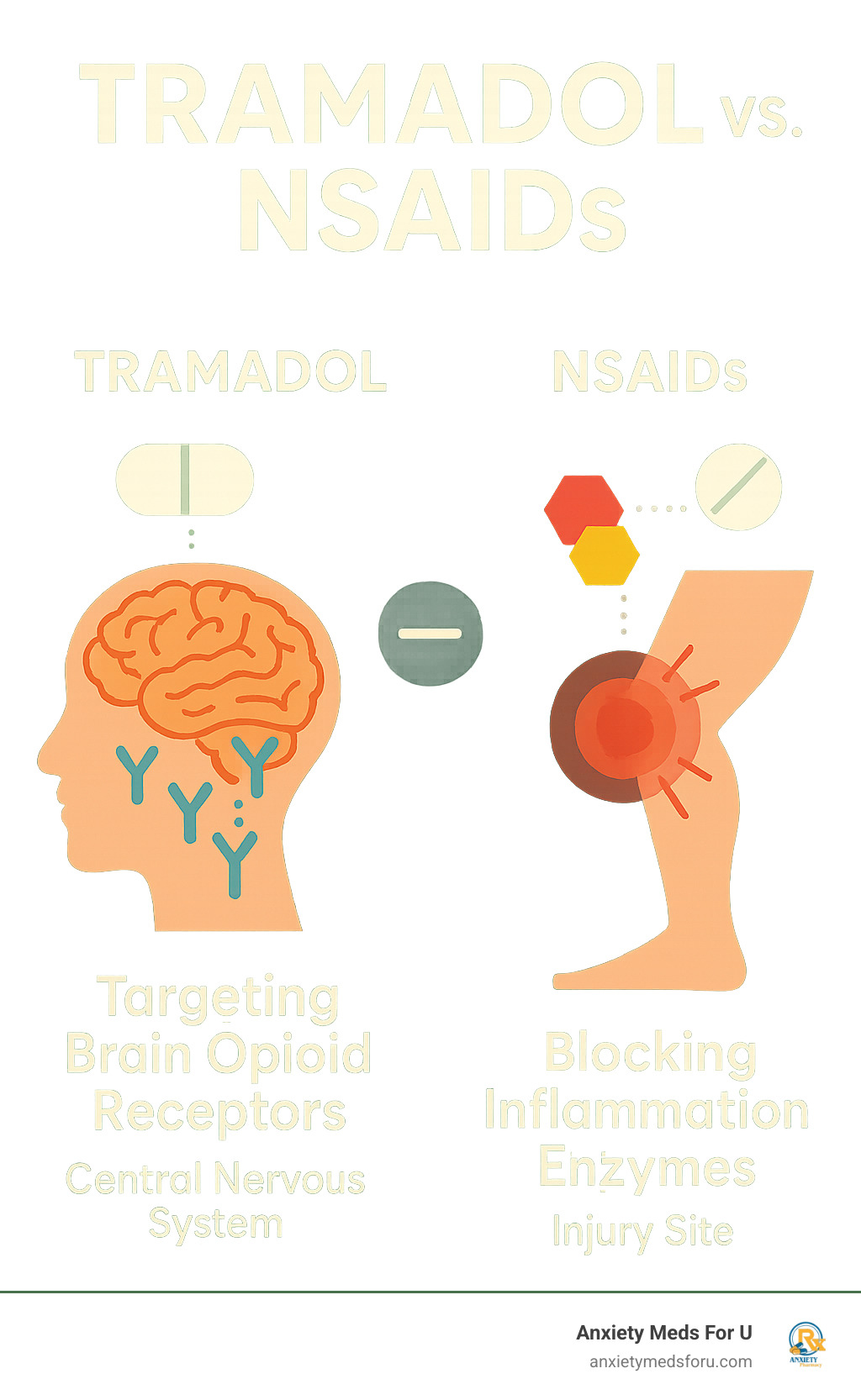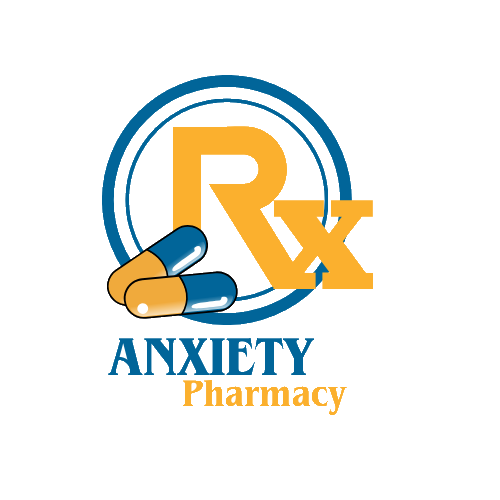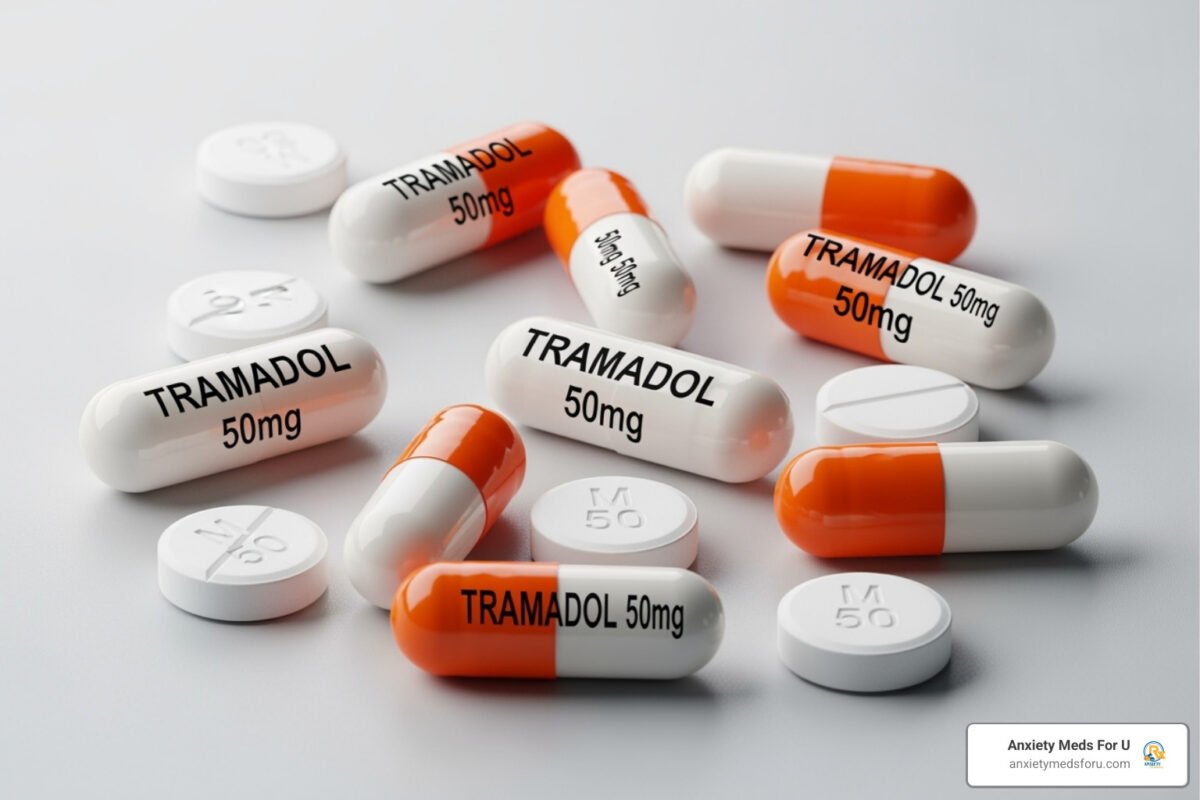NSAID or Opioid? The Real Story Behind Tramadol

Understanding the Confusion Around Tramadol’s Classification
Is tramadol an NSAID? The answer is a clear and unequivocal no. Tramadol is not a nonsteroidal anti-inflammatory drug (NSAID), and this common misconception can lead to significant confusion and potentially unsafe choices for people trying to manage their pain effectively.
The confusion is understandable. Both tramadol and NSAIDs are used to treat pain, so it’s easy to group them together mentally. However, their internal workings, risks, and appropriate uses are worlds apart.
Quick Answer Breakdown:
- Tramadol: This is a centrally-acting opioid analgesic. The term “analgesic” simply means pain reliever. It works by changing how your central nervous system (your brain and spinal cord) responds to pain signals.
- NSAIDs: This category includes common drugs like ibuprofen and naproxen. They are anti-inflammatory agents that work directly at the site of an injury to reduce swelling and irritation.
- The Key Difference: Tramadol targets the brain’s perception of pain, while NSAIDs target the physical inflammation in the body.
Many people mistakenly believe tramadol is just a stronger version of an over-the-counter pain reliever. In reality, tramadol is a synthetic opioid. This means it’s created in a laboratory rather than derived directly from the opium poppy, but it’s designed to act on the same receptors in the brain as drugs like morphine. Because of its potential for abuse and dependence, the U.S. Drug Enforcement Administration (DEA) classifies tramadol as a Schedule IV controlled substance.
In stark contrast, NSAIDs like ibuprofen or naproxen work through a completely different biological pathway. They block specific enzymes responsible for creating inflammation at the site of an injury. This is why they are so effective at reducing the swelling, redness, and pain of a sprained ankle. Tramadol does not reduce swelling or inflammation at all.
This mix-up is more than just a technicality; it has real-world consequences. Using the wrong type of medication can mean your pain isn’t treated effectively and you might expose yourself to unnecessary side effects and risks. Understanding these fundamental differences is the first step toward making informed and safe decisions about your pain management plan.

Simple guide to is tramadol an nsaid terms:
The Straight Answer: Is Tramadol an NSAID?
Let’s cut to the chase and give you the straight answer: Is tramadol an NSAID? No, it absolutely is not. This isn’t a minor detail or a point of medical debate; it’s a fundamental distinction that impacts how the drug works, its intended use, its side effect profile, and its legal status.
So, what is tramadol? It’s officially classified as a synthetic opioid analgesic. Let’s break that down. “Synthetic” means it is entirely man-made in a laboratory, distinguishing it from natural opiates like morphine (derived from the poppy plant) or semi-synthetic opioids like oxycodone (which starts with a natural opiate and is modified). “Opioid analgesic” means it relieves pain by acting on opioid receptors in your central nervous system.
When you take tramadol, it travels through your bloodstream to your brain and spinal cord. There, it binds to specific sites called mu-opioid receptors. Activating these receptors effectively interrupts the pain messages being sent from your body, telling your brain to dial down the sensation of pain. It changes your perception of pain rather than fixing the underlying cause.
Recognizing its potential for dependence and abuse, the DEA reclassified tramadol as a Schedule IV controlled substance in 2014. This scheduling indicates that while it has accepted medical uses, it also carries a risk of physical or psychological dependence. You can find more details on what these classifications mean on the official DEA scheduling information page.
Now, let’s contrast this with NSAIDs. The acronym stands for Nonsteroidal Anti-Inflammatory Drug, and this class includes well-known medications like ibuprofen (Advil, Motrin), naproxen (Aleve), aspirin, and diclofenac. As their name implies, their primary job is to fight inflammation.
Here’s how NSAIDs work: They operate peripherally, right at the site of your injury. They work by blocking enzymes called cyclooxygenases, specifically COX-1 and COX-2. These enzymes are responsible for producing chemicals called prostaglandins, which are key players in creating the pain, fever, and inflammation you feel when you’re hurt. The COX-1 enzyme also helps protect your stomach lining, which is why blocking it can sometimes lead to stomach upset or ulcers. COX-2 is more directly involved in the inflammatory response.
So, if you twist your knee and it swells up, an NSAID goes to work in the knee itself, telling the COX enzymes to stop producing inflammatory prostaglandins. Tramadol, meanwhile, ignores the swollen knee and goes straight to your brain to change how you feel the pain from that knee.
This is precisely why the answer to “is tramadol an nsaid” is so critical for your health. They are different tools for different jobs. Choosing the right one with your doctor depends entirely on the nature of your pain.
How Tramadol and NSAIDs Differ in Action and Effect

Now that we’ve firmly established that the answer to is tramadol an NSAID is a definitive “no,” we can explore the fascinating and distinct ways these two types of medication work inside your body. Understanding their different mechanisms of action is key to appreciating why one might be chosen over the other for your specific pain condition.
Tramadol’s Unique Dual-Action Mechanism
Tramadol stands out in pain relief because it doesn’t just do one thing—it has a dual mechanism of action. This two-pronged approach is what makes it effective for certain types of pain that other medications can’t touch.
First, as we’ve covered, tramadol works on the opioid pathway. It weakly binds to mu-opioid receptors in the brain and spinal cord. This is the classic opioid action that dulls the perception of pain, acting like a dimmer switch to turn down the intensity of pain signals reaching your brain.
But here’s the second, equally important part of its action: tramadol also functions as a serotonin and norepinephrine reuptake inhibitor (SNRI). This might sound like an antidepressant, and that’s because it uses a similar mechanism. Serotonin and norepinephrine are neurotransmitters that, among many other functions, play a crucial role in the body’s own pain-suppressing pathways. By preventing their reabsorption, tramadol leaves more of these chemicals available in the nervous system, which helps to naturally inhibit pain signals. This SNRI activity is why tramadol can be particularly effective for chronic and neuropathic pain conditions (nerve pain), like fibromyalgia or diabetic neuropathy. If you’re interested in the deep science, you can learn more on Tramadol’s pharmacology.
Do Tramadol’s Effects Include Reducing Inflammation or Swelling?
This is a critical point that cannot be overstated: tramadol has no clinically significant anti-inflammatory properties. It will not reduce swelling, calm redness, or address the underlying inflammation that is often the source of pain. Zero. None.
Imagine you have a painful, swollen joint due to a gout flare-up. If you take tramadol, it may make you feel the pain less because it’s working on your brain. However, the joint itself will remain just as swollen and inflamed. The medication is merely masking the pain, not treating the root cause.
This is precisely why NSAIDs are the superior choice for inflammatory conditions. For issues like arthritis, tendinitis, bursitis, menstrual cramps, or post-surgical swelling, an NSAID is far more effective. It directly targets the problem by blocking the production of inflammatory prostaglandins. By reducing the inflammation, you directly reduce the pain. Abundant research on tramadol’s anti-inflammatory effects confirms its lack of this crucial action, highlighting why it is not a substitute for an NSAID when inflammation is present.
Tramadol vs. NSAIDs: A Side-by-Side Comparison
To make the differences perfectly clear, let’s compare these medications directly. This table illustrates why the answer to is tramadol an NSAID is a firm no.
| Feature | Tramadol | NSAIDs |
|---|---|---|
| Drug Class | Synthetic opioid analgesic | Nonsteroidal anti-inflammatory drug |
| Mechanism | Acts on brain opioid receptors + blocks serotonin/norepinephrine reuptake | Blocks COX enzymes to reduce prostaglandin production |
| Anti-inflammatory Action | No anti-inflammatory effects | Directly reduces inflammation and swelling |
| Primary Use Case | Moderate to severe pain (especially neuropathic or when NSAIDs fail) | Mild to moderate pain driven by inflammation |
| Prescription Required | Yes – Schedule IV controlled substance | Some OTC (ibuprofen, naproxen), some prescription-only |
| Addiction Risk | Moderate risk of dependence and withdrawal | Very low to no addiction potential |
| Common Side Effects | Drowsiness, nausea, constipation, dizziness, headache | Stomach upset, heartburn, increased bleeding risk, kidney concerns |
This comparison highlights that the choice between tramadol and an NSAID is not about which one is “stronger” in a general sense, but which one is the right tool for the specific job. A patient with a history of stomach ulcers or kidney disease might need to avoid NSAIDs, making tramadol a potential alternative. Conversely, for a patient with a history of substance use disorder, the risks of tramadol would be a major concern. These are fundamentally different medications for different clinical scenarios.













